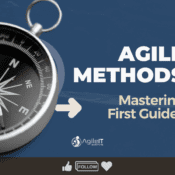Agile Mindset: Learn How to Put Customers at the Center of Everything You Do
Agile Mindset: Learn How to Put Customers at the Center of Everything You Do
The world of project management has evolved significantly in recent years. A
And one of the most prominent changes has been the rise of agile methodologies.
While there are many different frameworks and approaches that fall under the umbrella of “agile,” they all share a common philosophy or mindset.
At its core, an agile mindset is about embracing change as a constant.
Focusing on customer needs, collaborating effectively across teams to achieve better outcomes.
It emphasizes continuous improvement through feedback loops and encourages experimentation to achieve better results.
In contrast to traditional project management methods which emphasize predictability through upfront planning phases…
Agile promotes flexibility by recognizing that requirements can change throughout projects’ life cycles.
The approach focuses on delivering value incrementally instead of aiming for perfection from day one.
Having an Agile Mindset helps professionals in IT Projects deliver value faster while being adaptable to unexpected events or changes.
When working with Scrum methodology specifically (one popular implementation framework), this means breaking down work into smaller chunks called sprints, prioritizing tasks based on business priorities & stakeholders input only.
Then delivering them within short time frames typically two weeks long or less.
Adopting this mentality can help you become more efficient and effective in your work.
While also delivering better outcomes for your customers. In today’s fast-paced business environment where technology evolves so rapidly – having this type of agility is critical when managing complex IT projects!
So let’s dive into understanding how developing an Agile Mindset will make you stand out from others when working with IT projects!
Importance of embracing agile mindset in career transition
Adopting an Agile Mindset is critical when transitioning to a new role or career, especially within IT projects.
This way of thinking has become increasingly important as businesses demand greater flexibility and responsiveness from their project teams.
Here are some reasons why it’s essential to embrace the Agile Mindset during your career transition journey:
1. Deliver Value Faster:
An Agile approach requires working with smaller increments that can be delivered quickly while still providing value to customers.
By focusing on delivering incrementally, you’ll not only see results faster but also get feedback on what works and what doesn’t work so you can improve accordingly.
2. Collaborate Effectively:
One key aspect of Agile is collaboration across departments and cross-functional teams.
This means that everyone involved in the project must work together towards common goals instead of siloed objectives – this leads to better communication among team members and ultimately better outcomes for stakeholders.
3. Adaptability:
The ability to adapt quickly when changes occur is crucial if you want success with IT projects today.
This is where Agility comes into play since its iterative nature encourages adaptation over predictability through upfront planning phases which may lead organizations astray from real business needs.
4. Continuous Improvement:
Adopting an Agile Mindset means being open-minded about learning from experiences. Both good and bad ones.
Continuously improving processes based upon feedback loops generated by retrospectives meetings.
After each sprint cycle iteration helps build robust knowledge-sharing cultures that foster growth opportunities within team members’ careers & development paths!
5. Customer Focus:
Finally, one fundamental principle behind adopting an agile mindset is putting customer needs at the center stage throughout all stages of any given initiative or software development lifecycle (SDLC).
Understanding customer requirements well before starting anything ensures alignment between technology deliverables & business objectives always happens naturally without much friction along the way!
In conclusion, adopting an agile mindset during your career transition journey will help you succeed as a professional in IT Projects.
By enabling you to deliver value faster, collaborate effectively across teams/departments/organizations, seamlessly adapt changing environments more easily than ever before while keeping continuous improvement at heart!
II. Customer Focus: Putting Customers at the Center of Everything You Do:
One key aspect of an Agile Mindset is putting customers first.
This involves understanding their needs and expectations and ensuring that all decisions made are in line with those requirements.
There are some ways you can put customers at the center of everything you do when working on IT projects.
One way to ensure customer focus is by using user stories – short descriptions that capture specific customer needs or pain points.
These stories help teams stay focused on delivering value to users instead of getting bogged down in technical details or other distractions.
Another way to keep your focus on customers is through feedback loops generated from frequent demos, showcases, or any other form where stakeholders can see progress happening along every iteration cycle (sprint).
Gathering input early & often helps avoid costly rework later as well as providing valuable insights into what works best for business objectives.
When deciding which features/requirements should be prioritized within each sprint cycle, always take into account business value over technical complexity alone.
This ensures that efforts go towards delivering items with significant impact rather than just checking off boxes without much real-world use cases behind them!
Finally, continuous improvement should also apply regarding how products/services get delivered throughout project lifecycle phases.
Whether via software testing automation tools implementation or adopting DevOps methodologies like CI/CD pipelines integration into development workflows.
These approaches prioritize quality assurance while still maintaining agility levels required by modern businesses today.
In conclusion, putting customers first means making sure their needs remain top priority during all stages involved in IT projects management processes.
Since from planning up until deployment releases happen seamlessly without causing issues among end-users’ experiences along the way!
I hope you have enjoyed this lesson 😊 While the second lesson is on the way, please, fell free to send us your thoughts or questions about an Agile Career Transition.
Have a nice day! See you soon 😊

